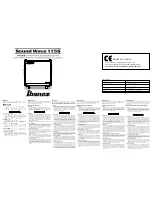
VM-1H4C – Getting Started
3
BC-DGKat7a23
(CAT 7a 23 AWG cable). These specially built cables significantly
outperform regular CAT 5/CAT 6 /CAT 7a cables.
The
VM-1H4C
supports a range of up to 90m (295ft) at 1080i/SXGA or up to 30m
(98ft) at 1080p/UXGA on shielded
BCP-DGKat524
cable; 90m (295ft) at 1080i or
up to 70m (230ft) at 1080p/UXGA on shielded
BCP-DGKat623
cable; 100m
(295ft) at 1080i or up to 80m (262ft) at 1080p/UXGA on shielded
BCP-DGKat723
cable.
You can daisy-chain up to six DigiKat devices with the maximum overall distance
between the first and last devices being cumulative and limited by the cable type
used.
2.3
About the Power Provision Feature
Only the
VM-1H4C
needs to be connected to a power source when the devices
are within 90m (270ft) of each other – the
VM-1H4C
can provide power to the
receiver over the TP cable. This feature applies as long as the cable can carry
power and the distance does not exceed 90m on standard TP cable. For longer
distances, heavy gauge cable should be used (standard TP cable is still suitable
for the video/audio transmission, but not for feeding the power at these distances).
2.4
Defining EDID
The Extended Display Identification Data (EDID) is a data-structure provided by a
display to describe its capabilities to a graphics card (that is connected to the
display’s source). The EDID enables the
VM-1H4C
to “know” what kind of monitor
is connected to the output. The EDID includes the manufacturer’s name, the
product type, the timing data supported by the display, the display size, luminance
data and (for digital displays only) the pixel mapping data.
EDID is defined by a standard published by the Video Electronics Standards
Association (VESA).

































